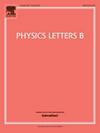在s=13和13.6 TeV的顶夸克和Z玻色子事件中寻找CP违背
IF 4.5
2区 物理与天体物理
Q1 ASTRONOMY & ASTROPHYSICS
引用次数: 0
摘要
在与Z玻色子相关的顶夸克的产生过程中,利用至少有三个带电轻子和附加喷流的事件,对电荷-奇偶性(CP)对称性的破坏进行了搜索。该搜索是在CERN大型强子对撞机的CMS实验中收集的质子-质子碰撞数据样本中进行的,2016-2018年质心能量为13 TeV, 2022年质心能量为13.6 TeV,对应的总积分光度为173 fb−1。在这种最终状态下,首次使用了在CP变换下为奇数的可观测值。此外,物理学知识的机器学习技术第一次被用于构建这些可观测值。虽然对于标准模型(SM)过程,这些可观测值的分布被预测为在零周围对称,但SM的违反cp的修改将引入不对称。考虑了SM有效场论中两个cp奇算子OtWI和OtZI可能改变顶夸克与电弱玻色子之间的相互作用。所得结果与SM预测在两个标准差范围内一致,相关Wilson系数为- 2.7< cttwi <;2.5和- 0.2<ctZI<;2.0的排除限设置为95%置信水平。在ctzi中观察到最大的差异,其中数据与正值一致,当仅考虑线性项时,相对于2.5个标准差的SM假设观察到局部显著性。本文章由计算机程序翻译,如有差异,请以英文原文为准。
Search for CP violation in events with top quarks and Z bosons at s=13 and 13.6 TeV
A search for the violation of the charge-parity (CP) symmetry in the production of top quarks in association with Z bosons is presented, using events with at least three charged leptons and additional jets. The search is performed in a sample of proton-proton collision data collected by the CMS experiment at the CERN LHC in 2016–2018 at a center-of-mass energy of 13 TeV and in 2022 at 13.6 TeV, corresponding to a total integrated luminosity of 173 . For the first time in this final state, observables that are odd under the CP transformation are employed. Also for the first time, physics-informed machine-learning techniques are used to construct these observables. While for standard model (SM) processes the distributions of these observables are predicted to be symmetric around zero, CP-violating modifications of the SM would introduce asymmetries. Two CP-odd operators and in the SM effective field theory are considered that may modify the interactions between top quarks and electroweak bosons. The obtained results are consistent with the SM prediction within two standard deviations, and exclusion limits on the associated Wilson coefficients of and are set at 95 % confidence level. The largest discrepancy is observed in where data is consistent with positive values, with an observed local significance with respect to the SM hypothesis of 2.5 standard deviations, when only linear terms are considered.
求助全文
通过发布文献求助,成功后即可免费获取论文全文。
去求助
来源期刊

Physics Letters B
物理-物理:综合
CiteScore
9.10
自引率
6.80%
发文量
647
审稿时长
3 months
期刊介绍:
Physics Letters B ensures the rapid publication of important new results in particle physics, nuclear physics and cosmology. Specialized editors are responsible for contributions in experimental nuclear physics, theoretical nuclear physics, experimental high-energy physics, theoretical high-energy physics, and astrophysics.
 求助内容:
求助内容: 应助结果提醒方式:
应助结果提醒方式:


